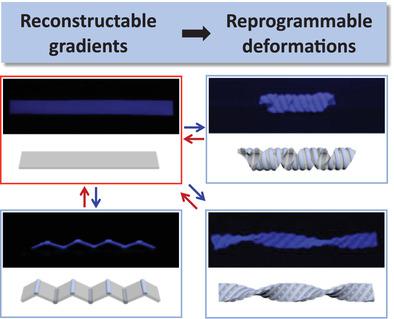当前位置:
X-MOL 学术
›
Adv. Mater.
›
论文详情
Our official English website, www.x-mol.net, welcomes your
feedback! (Note: you will need to create a separate account there.)
Reconstructable Gradient Structures and Reprogrammable 3D Deformations of Hydrogels with Coumarin Units as the Photolabile Crosslinks
Advanced Materials ( IF 27.4 ) Pub Date : 2021-03-31 , DOI: 10.1002/adma.202008057 Chao Nan Zhu 1 , Chen Yu Li 1 , Hu Wang 2 , Wei Hong 3 , Feihe Huang 2 , Qiang Zheng 1 , Zi Liang Wu 1
Advanced Materials ( IF 27.4 ) Pub Date : 2021-03-31 , DOI: 10.1002/adma.202008057 Chao Nan Zhu 1 , Chen Yu Li 1 , Hu Wang 2 , Wei Hong 3 , Feihe Huang 2 , Qiang Zheng 1 , Zi Liang Wu 1
Affiliation

|
Morphing hydrogels have versatile applications in soft robotics, flexible electronics, and biomedical devices. Controlling component distribution and internal stress within a hydrogel is crucial for shape‐changing. However, existing gradient structures of hydrogels are usually non‐reconstructable, once encoded by chemical reactions and covalent bonds. Fabricating hydrogels with distinct gradient structures is inevitable for every new configuration, resulting in poor reusability, adaptability, and sustainability that are disadvantageous for diverse applications. Herein, a hydrogel containing reversible photo‐crosslinks that enable reprogramming of the gradient structures and 3D deformations into various configurations is reported. The hydrogel is prepared by micellar polymerization of hydrophobic coumarin monomer and hydrophilic acrylic acid. The presence of hexadecyltrimethylammonium chloride micelles increases the local concentration of coumarin units and also improves the mechanical properties of the hydrogel by forming robust polyelectrolyte/surfactant complexes that serve as the physical crosslinks. High‐efficiency photodimerization and photocleavage reactions of coumarins are realized under 365 and 254 nm light irradiation, respectively, affording reversible tuning of the network structure of the hydrogel. Through photolithography, different gradient structures are sequentially patterned in one hydrogel that direct the deformations into distinct configurations. Such a strategy should be applicable for other photolabile hydrogels toward reprogrammable control of network structures and versatile functions.
中文翻译:

以香豆素为光不稳定交联剂的水凝胶的可重构梯度结构和可重编程3D变形
变形水凝胶在软机器人,柔性电子和生物医学设备中具有广泛的应用。控制水凝胶中的组分分布和内部应力对于改变形状至关重要。然而,现有的水凝胶梯度结构一旦被化学反应和共价键编码,通常是不可重构的。对于每种新配置,都不可避免地要制造出具有独特梯度结构的水凝胶,从而导致不良的可重复使用性,适应性和可持续性,这不利于各种应用。本文报道了一种含有可逆光交联的水凝胶,该光交联使得能够对梯度结构和3D变形重新编程为各种构型。通过疏水性香豆素单体和亲水性丙烯酸的胶束聚合制备水凝胶。十六烷基三甲基氯化铵胶束的存在增加了香豆素单元的局部浓度,并通过形成坚固的聚电解质/表面活性剂复合物来提高水凝胶的机械性能,所述复合物用作物理交联。香豆素的高效光致二聚化和光裂解反应分别在365和254 nm的光照射下实现,从而可逆调节水凝胶的网络结构。通过光刻,在一个水凝胶中依次对不同的梯度结构进行构图,从而将变形定向为不同的构型。这种策略应适用于其他光不稳定水凝胶,以实现对网络结构和通用功能的可重新编程控制。
更新日期:2021-05-05
中文翻译:

以香豆素为光不稳定交联剂的水凝胶的可重构梯度结构和可重编程3D变形
变形水凝胶在软机器人,柔性电子和生物医学设备中具有广泛的应用。控制水凝胶中的组分分布和内部应力对于改变形状至关重要。然而,现有的水凝胶梯度结构一旦被化学反应和共价键编码,通常是不可重构的。对于每种新配置,都不可避免地要制造出具有独特梯度结构的水凝胶,从而导致不良的可重复使用性,适应性和可持续性,这不利于各种应用。本文报道了一种含有可逆光交联的水凝胶,该光交联使得能够对梯度结构和3D变形重新编程为各种构型。通过疏水性香豆素单体和亲水性丙烯酸的胶束聚合制备水凝胶。十六烷基三甲基氯化铵胶束的存在增加了香豆素单元的局部浓度,并通过形成坚固的聚电解质/表面活性剂复合物来提高水凝胶的机械性能,所述复合物用作物理交联。香豆素的高效光致二聚化和光裂解反应分别在365和254 nm的光照射下实现,从而可逆调节水凝胶的网络结构。通过光刻,在一个水凝胶中依次对不同的梯度结构进行构图,从而将变形定向为不同的构型。这种策略应适用于其他光不稳定水凝胶,以实现对网络结构和通用功能的可重新编程控制。































 京公网安备 11010802027423号
京公网安备 11010802027423号